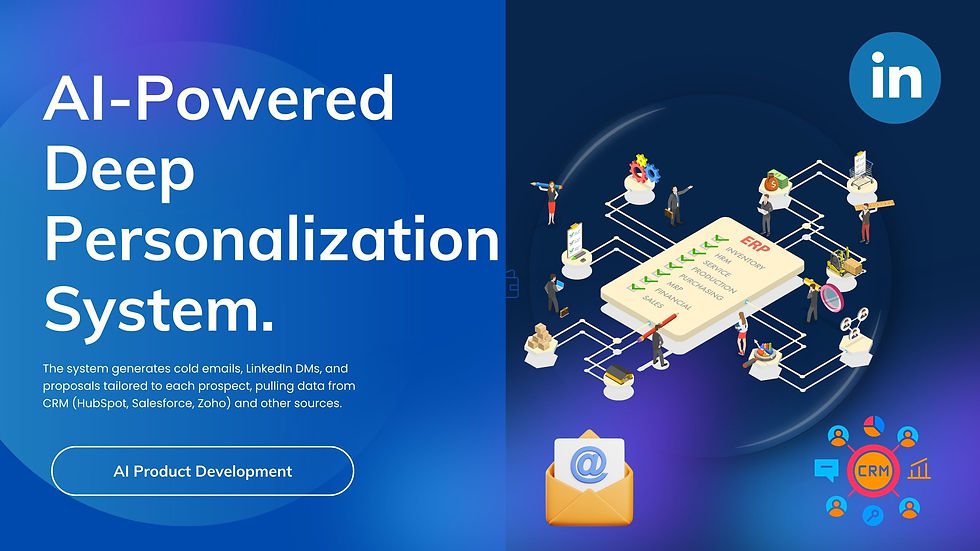AI-Powered Deep Personalization System | AI Product Development
- Codersarts AI

- Aug 27
- 4 min read
Welcome to the Codersarts AI Product Development series! In today's blog, we'll explore SaaS project ideas, startup concepts, or solutions for individuals seeking such innovations. At Codersarts, we specialize in AI product development and consulting. Let's delve into the details of the project requirement document.
The Deep Personalization System is a productized service designed to automate and enhance cold email outreach. This system will leverage artificial intelligence and public data sources to generate highly personalized and contextually relevant email content at scale. Our goal is to provide a templated, easy-to-deploy solution for businesses and sales professionals who need to improve their cold outreach open and conversion rates without significant manual effort.
Problem Statement
Standard cold email campaigns often suffer from low engagement due to generic, one-size-fits-all messaging. Manual personalization is time-consuming and not scalable for high-volume outreach. Businesses are looking for a way to achieve the high response rates of personalized emails with the efficiency of automated campaigns.

1. Executive Summary
The AI-Powered Deep Personalization System enables B2B agencies, SaaS startups, and recruiters to scale their outreach while maintaining authenticity and personalization. The system generates cold emails, LinkedIn DMs, and proposals tailored to each prospect, pulling data from CRM (HubSpot, Salesforce, Zoho) and other sources.
The system is designed to:
Improve outreach conversion rates.
Reduce manual research time.
Provide multilingual personalization for global campaigns.
2. Goals & Objectives
Primary Goal: Automate hyper-personalized outreach that cuts through noise and drives higher engagement.
Objectives:
Build AI agents that generate personalized outreach messages at scale.
Seamlessly integrate with CRM platforms (HubSpot, Salesforce, Zoho).
Enable multilingual support for global campaigns.
Provide analytics (open rates, reply rates, engagement insights).
Ensure compliance with GDPR/CCPA and avoid spam-like patterns.
3. Target Users
B2B Agencies → Marketing & lead generation teams.
SaaS Startups → Sales teams targeting enterprise clients.
Recruiters & HR Firms → Personalized candidate/recruiter outreach.
4. Key Features & Requirements
4.1 Core Features
AI Personalization Engine
Uses LLMs (GPT-4.1, LLaMA, or fine-tuned models).
Inputs: Prospect name, company, role, industry, recent activity.
Outputs: Cold email, LinkedIn DM, or proposal draft.
CRM Integration
Import contact & company data from HubSpot, Salesforce, Zoho.
Sync interaction history (last email, last meeting, notes).
Auto-update engagement results back to CRM.
Content Templates
Pre-built templates for sales, recruiting, and B2B outreach.
User-defined templates with placeholders ({{FirstName}}, {{Company}}, {{PainPoint}}).
Multi-Language Support
Generate outreach in English, Spanish, German, French, Hindi, etc.
Detect prospect’s language from LinkedIn/CRM data.
Analytics Dashboard
Track open rates, click rates, reply rates.
A/B testing for different AI-generated variations.
4.2 Advanced Features (Phase 2)
LinkedIn Scraper Add-On: Pull recent posts, activity, mutual connections to enrich personalization.
Proposal Generator: Auto-generate mini one-page proposals (PDF/Docx).
Outreach Sequences: AI-powered multi-step campaigns (follow-ups).
Smart Spam Control: Auto-check for spam words, sender reputation monitoring.
5. System Architecture
Frontend: React.js (Dashboard + Templates + Analytics).
Backend: Python/Django or FastAPI.
AI Layer: OpenAI GPT / LLaMA / Codersarts fine-tuned models.
CRM Integration: REST/GraphQL APIs for HubSpot, Salesforce, Zoho.
Database: PostgreSQL/MySQL for storage.
Analytics Tracking: Custom event logging + Google Analytics integration.
Deployment: Docker + AWS/GCP/Azure.
6. Non-Functional Requirements
Scalability: Must handle 10,000+ outreach messages/day.
Performance: Message generation under 3 seconds.
Security: OAuth2.0 for CRM integrations, encrypted storage.
Compliance: GDPR/CCPA ready, opt-out handling.
Usability: Simple UX for non-technical salespeople.
7. KPIs & Success Metrics
Outreach response rate increase by 30–50%.
Average time saved per rep: 10+ hours/week.
Multilingual adoption by global clients.
Monthly recurring revenue from retainers.
8. Timeline & Roadmap
Phase 1 (4–6 weeks):
AI personalization engine
CRM integration (HubSpot first)
Templates + multilingual support
Basic analytics
Phase 2 (6–8 weeks):
Advanced CRM integrations (Salesforce, Zoho)
LinkedIn enrichment module
Proposal generator
A/B testing & spam detection
Phase 3 (Ongoing):
Scale to other CRMs/ATS
Marketplace for outreach templates
Continuous AI model fine-tuning
9. Risks & Mitigations
Risk: Emails marked as spam → Mitigation: Smart spam filter, human review option.
Risk: CRM API rate limits → Mitigation: Batch sync, caching.
Risk: Generic AI outputs → Mitigation: Industry-specific fine-tuning + human-in-the-loop.
10. Business Model
Setup Fee: $2,000–$7,000 depending on scope.
Retainer: $500–$2,000/month for optimization + analytics.
Upsells: Additional languages, advanced CRM integrations, custom dashboards.
11. Next Steps
Build MVP (AI engine + HubSpot integration + basic templates).
Pilot with 2–3 B2B agencies or recruiters.
Collect metrics → Case studies → Marketing collateral.
Scale to SaaS startups and enterprise sales teams.
Workflow Diagram
Step 1. Data Ingestion
Import prospect details from CRM (HubSpot, Salesforce, Zoho)
Enrich with LinkedIn, company site, public sources
Step 2. Personalization Engine
AI analyzes prospect’s role, company, pain points, recent activity
Templates with placeholders are filled (name, industry, interests)
Multilingual generation (English, Spanish, German, etc.)
Step 3. Outreach Message Creation
Generates email, LinkedIn DM, or proposal draft
Runs spam compliance check
User can preview/edit
Step 4. Sending & Integration
Sends via CRM or connected email system
Logs message in CRM automatically
Step 5. Analytics & Optimization
Tracks open rate, clicks, replies
A/B testing of variations
Feedback loop → fine-tune AI outputs
Schedule your 30-min discovery call with Codersarts today



Comments